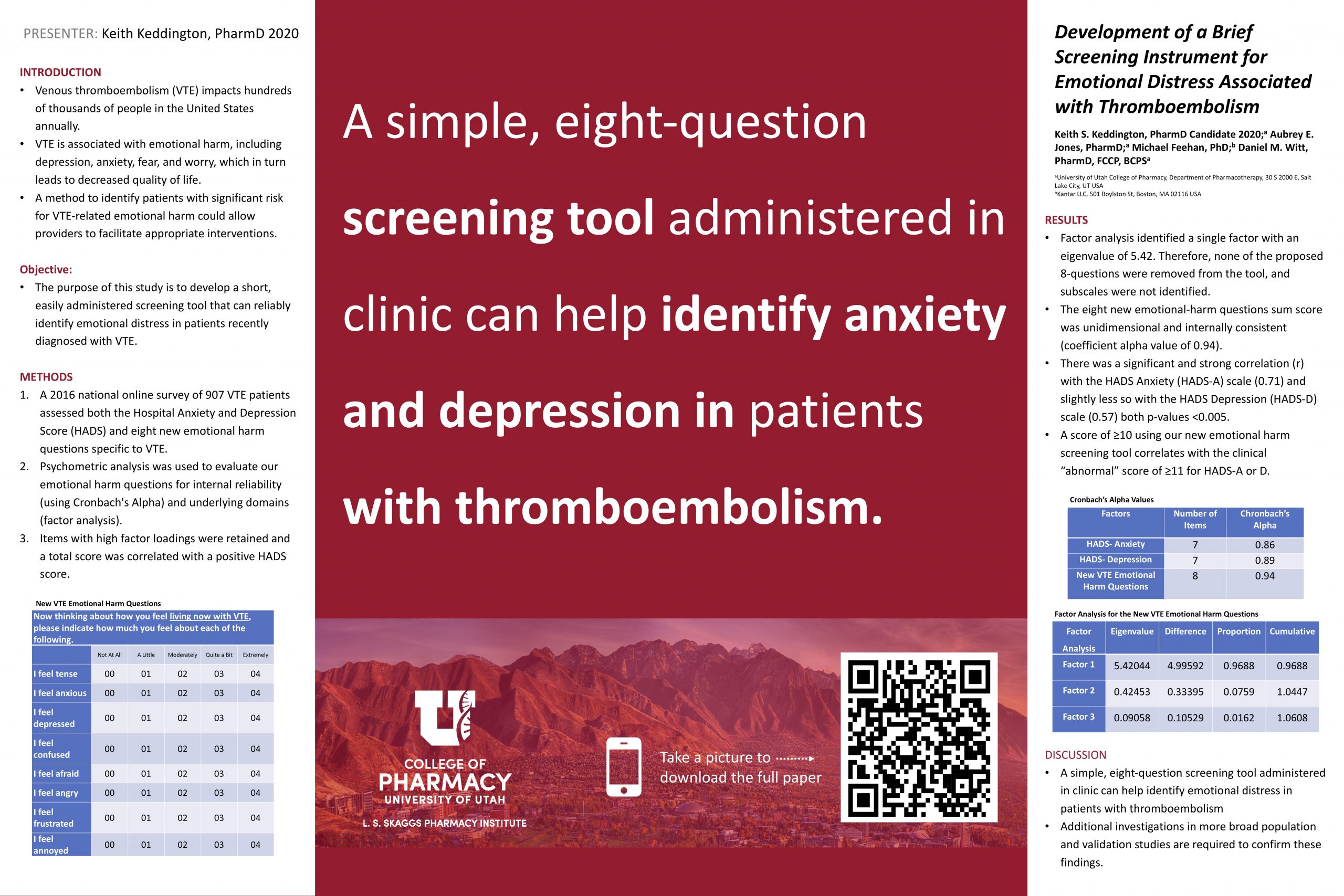
Background: Venous thromboembolism (VTE) is associated with emotional distress, including depression, anxiety, fear, and decreased quality of life. A method to rapidly screen patients at elevated risk for VTE-related emotional distress could allow providers to facilitate appropriate interventions.
Objective: To develop a short, easily administered screening tool that can reliably identify emotional distress in patients recently diagnosed with VTE.
Methods: An analysis was performed on extant data from a cross-sectional national online survey of adult patients who recently suffered VTE episodes. The survey included eight questions developed by our team to assess VTE-related emotional distress, as well as the validated Hospital Anxiety and Depression Scale (HADS). Psychometric analysis was used to evaluate our emotional distress questions for internal consistency and determine associations with HADS anxiety and depression scores.
Results: A total of 907 surveys were included in the analysis. Factor analysis of the proposed eight questions identified a single factor with an eigenvalue of 5.42. There was a significant and strong correlation with the HADS Anxiety (HADS-A) and HADS Depression (HADS-D) subscale scores, (r=0.71 and r=0.57, respectively), both p-values <0.005. A total score of 10 using our new emotional distress screening tool correlated with HADS-A and HADS-D scores of 10.5 and 9.0, respectively.
Conclusions: We developed and tested a new brief screening tool composed of 8 questions that assess the specific population of patients with VTE for emotional distress and is easily administered in a clinical setting. Additional investigations in broader populations and in validation studies are required to confirm these findings and foster the scales routine use in clinical practice.
Good job, Keith. If you were going to design the next study to further evaluate this emotional distress screening tool, how would you go about it?
(see post below)
Great work. I’m sorry you didn’t get to give that podium presentation! Like Dr. Witt I’m curious about the next step with new patients. Do you think they would try using it at the U?
(see post below)
Keith, very nicely done work and poster. I hope that you found this experience enlightening and that you’ll continue to pursue inquiry throughout your career. One question I have about the work is the advantage of this new tool or what the need was that drove its development. Since it is significantly correlated with the HADS scores, what is the advantage? Is it simply the length (8 questions vs. 14)?
Thank you! It has been very enlightening and enjoyable working on this project. As you mentioned, our tool is shorter (8 vs 14 questions) and simpler to assess (HADS anxiety and depression components), but more importantly, our tool was validated in a population of VTE patients and is specific to their distress, “thinking about how you feel living now with VTE, answer the following questions:” We used HADS as a reference because it has been previously validated and widely accepted for general harm. While we certainly feel justified that there was a strong correlation between the two, I believe that our tool more directly assesses the emotional distress regarding VTE diagnosis treatment and has a place in thrombosis patient care. This will certainly need to be confirmed with more research.
Dr. Witt and Dr. Henchey,
Thank you both for your comments and questions. I feel like the next steps are clinical implementation and I do believe the U would have an interest in participating. I believe that this tool could help continue to shift care towards a more complete patient-centric model and improve outcomes. In a clinical setting, I would first want a small pilot program with a few clinicians to get their feedback on how the tool performs and if there is any additional burden to the clinical workflow. I would then like to assess the tool with thrombosis clinic patients in an RCT comparing our tool to HADS to make sure the data collected in the online survey matches clinical expectations. Ideally, we could refer patients that are positive to receive some sort of intervention and follow-up over a period of time to see if their emotional distress resolved differently compared to a control. I think there’s a lot of potential for future work with this!
Hi Keith,
Great poster and research information. Seems like a great idea to have a questionnaire for these patients to fill out. Should be all about the whole of the patient – if they are extremely anxious and depressed will they understand/listen to the medication regimen? Knowing this info would help in how you teach these patients.
Sure excited you’ll be finishing soon! Congratulations!
Nice job on this project! Screening tools like this can be very effective.
Great job Keith! I really liked the layout. Diana
Nice job Keith. This is reminiscent of the Diabetes Distress Scale used to help distinguish between distress and depression. Congrats on graduation!